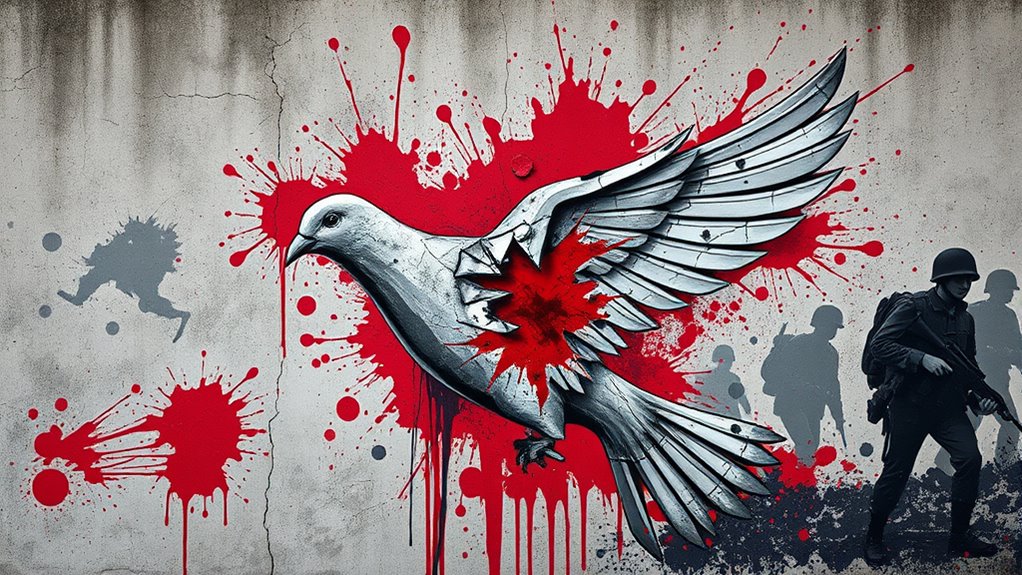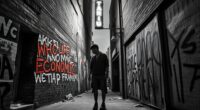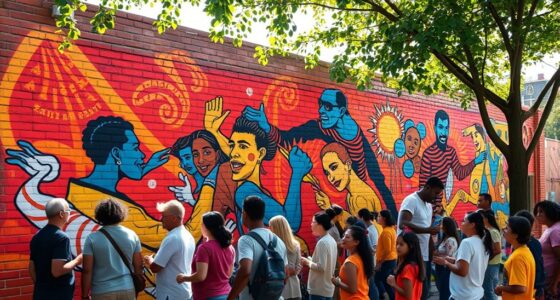Anti-war art uses powerful visuals to challenge your perceptions and highlight the human suffering caused by conflict. Through symbolism, color, and composition, it evokes emotional responses like empathy or anger and exposes hidden truths behind patriotic imagery. These artworks reveal the emotional toll of war, often criticizing manipulation and propaganda. If you explore further, you’ll gain a deeper understanding of how artists use imagery to promote peace and social change.
Key Takeaways
- Anti-war art challenges viewers to confront human suffering and emotional impact of conflict through vivid imagery and symbolism.
- Artists use techniques like color contrast and composition to evoke empathy, anger, or despair in response to war.
- Visual responses often reveal propaganda tactics, exposing manipulation and encouraging critical analysis of wartime messages.
- Artwork personalizes the abstract nature of war by depicting civilians, landscapes, and families affected by conflict.
- Anti-war art serves as a tool for awareness, protest, and social change by inspiring reflection and advocating peace.

Anti-war art challenges you to confront the realities and human costs of conflict. It’s a powerful form of visual communication that goes beyond mere aesthetics, aiming to evoke strong emotional responses and provoke critical thought. When you encounter anti-war art, you’re invited to analyze not just the imagery but also the subtle messages embedded within it. Propaganda analysis becomes essential here, as many pieces deliberately challenge or subvert the narratives pushed by governments and media during wartime. These works peel back the layers of manipulated images and slogans, revealing the true human suffering behind the patriotic veneer. By doing so, anti-war art exposes the emotional impact of war, stirring feelings of empathy, anger, or despair in you. It forces you to see the faces behind the statistics, the stories behind the headlines, making the distant realities of conflict painfully immediate.
As you examine these artworks, you start to notice how artists use symbolism, color, and composition to influence your perception. Bright, aggressive reds might symbolize bloodshed and violence, while stark monochrome images can evoke despair and hopelessness. The emotional impact is carefully crafted, designed to bypass rational defenses and tap directly into your feelings. This visceral connection makes it harder to dismiss the horrors of war as distant or justified in abstract terms. Instead, you’re confronted with a visceral reminder of its toll on individual lives. Anti-war art often employs propaganda analysis techniques to deconstruct the messages it conveys, helping you understand how imagery was used to rally support or suppress dissent during conflicts. By analyzing these visual strategies, you gain insight into how art can serve as both a tool of persuasion and a form of resistance.
Furthermore, anti-war art compels you to question the narratives you’ve been told. It encourages you to look beneath surface-level messages and recognize the manipulative tactics behind wartime propaganda. This process enhances your emotional awareness of the human costs involved, making the abstract idea of “war” more tangible and immediate. When you see images of suffering civilians, damaged landscapes, or grieving families, the emotional impact becomes personal. You’re not just observing art; you’re witnessing a plea for peace, a protest against violence, and a reminder of the stakes involved. Anti-war art’s ability to analyze propaganda and evoke deep emotional reactions makes it a potent force for awareness and change. It challenges you to see the truth behind the images and consider your role in advocating for a more compassionate world. Additionally, understanding the contrast ratio used in visual compositions can deepen your appreciation of how artists manipulate light and dark to evoke specific emotional responses, emphasizing the stark realities of conflict.
Frequently Asked Questions
How Has Anti-War Art Evolved Over Different Historical Periods?
You see anti-war art evolve from simple propaganda to powerful protest pieces over history. In early periods, art mainly supported government narratives, but now you see more personal and emotional expressions challenging conflicts. Technological advances, like photography and digital media, amplify these messages, making anti-war art more accessible and impactful. You notice how artists use new tools to turn visual responses into compelling protests against violence and war.
What Materials Are Commonly Used in Anti-War Artworks?
You often use mixed media and recycled materials in anti-war art, turning everyday objects into powerful symbols of protest. Think of torn fabric, shattered metal, and discarded paper woven into compelling visuals that challenge conflict. These materials breathe new life into your message, emphasizing sustainability and resilience. By combining different textures and found objects, your work becomes a vivid voice against war, transforming trash into a call for peace.
How Do Artists Choose Symbols to Convey Anti-War Messages?
You choose symbols that have strong symbolic resonance and cultural references to effectively convey your anti-war message. By selecting imagery that resonates emotionally and culturally, you tap into shared experiences and beliefs, making your message more powerful. You might incorporate universally recognized symbols of peace or conflict, or adapt cultural references to reflect current issues. This deliberate choice helps your artwork communicate its stance clearly and evoke a strong emotional response.
What Impact Does Anti-War Art Have on Public Opinion?
You might think anti-war art doesn’t change minds, but it actually influences public perception considerably. By provoking emotional responses and sparking conversations, it harnesses social influence to challenge pro-war narratives. This art can sway opinions, foster empathy, and inspire activism. Even if some dismiss it, collective exposure to anti-war visuals gradually shifts societal attitudes, making a lasting impact on how conflict and peace are perceived.
How Do Governments Typically Respond to Anti-War Visual Campaigns?
Governments often respond to anti-war visual campaigns with censorship, trying to suppress or remove the artwork to control public opinion. They may also deploy propaganda countermeasures, creating their own visuals to sway perceptions in favor of the conflict. You might notice these tactics aimed at diminishing the impact of anti-war messages, but persistent artists and activists often find ways to bypass restrictions and keep their voices heard.
Conclusion
So, here you are, witnessing how art fights war without a single soldier stepping onto the battlefield. Ironically, it’s often the quietest images that scream the loudest, making you question if peace is just a canvas away. While bombs may destroy cities, art preserves hope, reminding us that even in chaos, creativity can be a powerful act of resistance. Who knew that peaceful strokes could be the fiercest weapons of all?









